 Welcome to our eighth ‘Spotlight Feature’. This month we will be focusing on a truly remarkable painting that Cecil Round created in 1881 – at just sixteen years old! Unusually for Cecil Round, the painting has a religious theme. It is a likeness of a very famous painting, that was originally produced by a sixteenth century Master.
Welcome to our eighth ‘Spotlight Feature’. This month we will be focusing on a truly remarkable painting that Cecil Round created in 1881 – at just sixteen years old! Unusually for Cecil Round, the painting has a religious theme. It is a likeness of a very famous painting, that was originally produced by a sixteenth century Master.
If you have been lucky enough to visit The National Gallery in London, you may have come across Ecce Homo, a masterpiece depicting a scene from the life of Jesus Christ, which was painted by Correggio around 1525-1530. The National Gallery’s website describes it, thus:
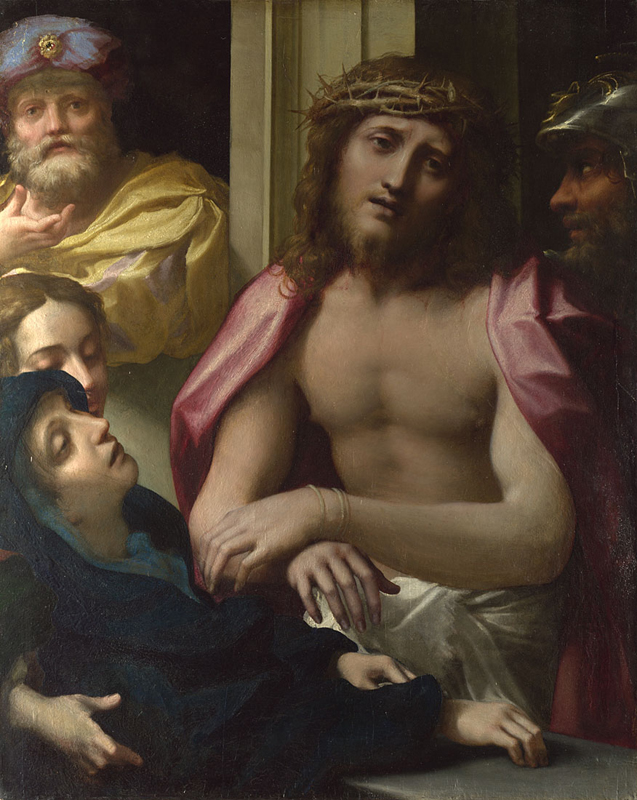
Correggio, active 1494; died 1534
Christ presented to the People (Ecce Homo)
probably about 1525-30
Oil on poplar, 99.7 x 80 cm
Bought, 1834
NG15
https://www.nationalgallery.org.uk/paintings/NG15
“In the New Testament, ‘Ecce Homo’ (Behold the Man) were the words used by Pilate when he presented Christ to the people before the Crucifixion (John 19: 2-5). The inclusion of the Virgin Mary swooning in the foreground is not mentioned in the Gospels and is not usually represented in this scene. The turbaned Pilate seems to derive from the print of the same subject in Dürer’s engraved ‘Passion’.”
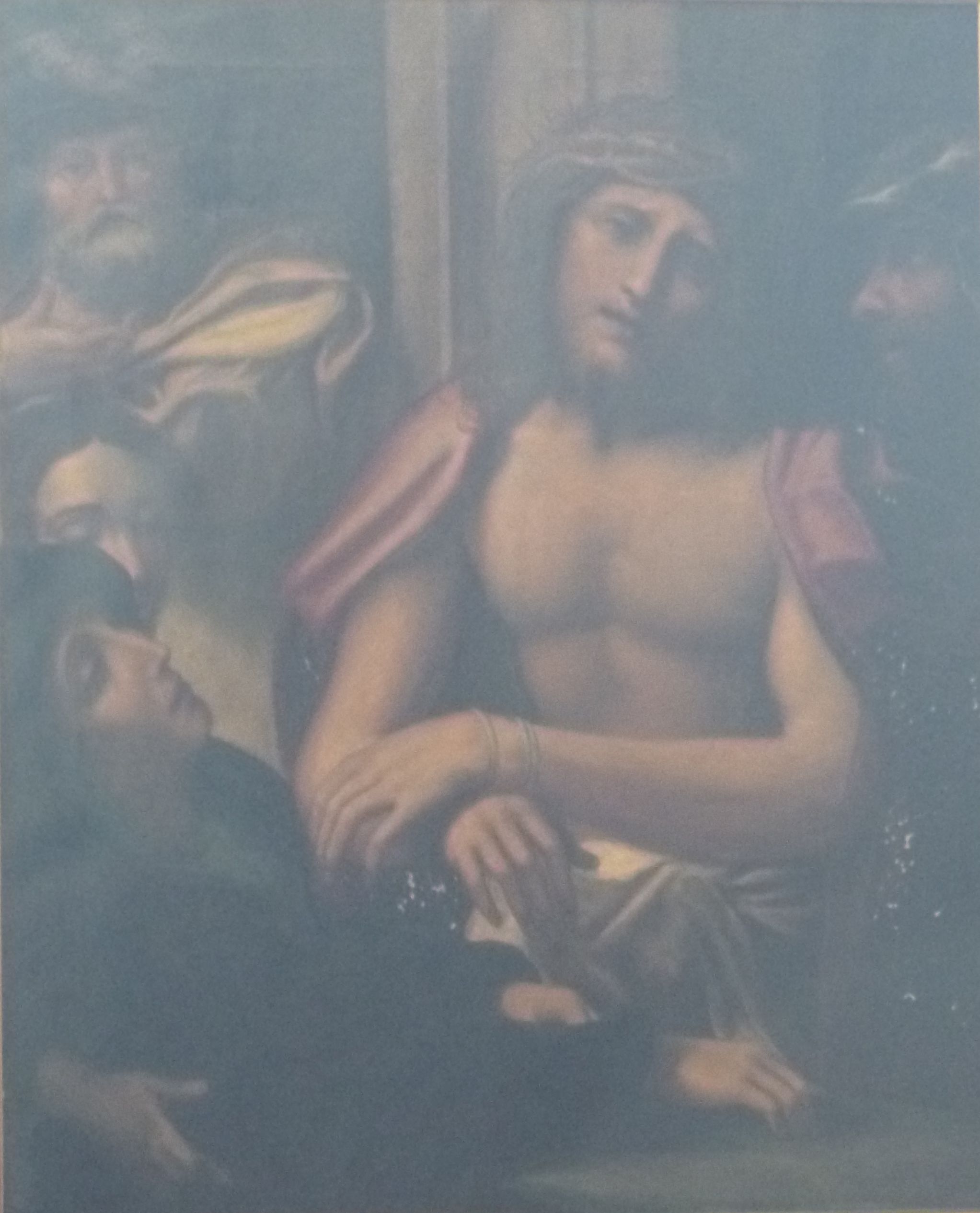 [Correggio’s Ecce Homo reproduced here with kind permission from The National Gallery, under their Creative Commons agreement.]
[Correggio’s Ecce Homo reproduced here with kind permission from The National Gallery, under their Creative Commons agreement.]
We are very grateful to Chris Warrell, Church Warden at St Luke’s Church in Eltham Park, London, for getting in touch with us a few years ago. He brought to our attention that Cecil Round’s version of the painting is on display in the Lady Chapel at St Luke’s. Being a 1:1 copy of the original, this is actually one of Cecil Round’s larger pictures, measuring 98 x 80 cm. Due to poor lighting within the chapel, it was no doubt difficult to take a photograph of the painting. However, you will see from the image on the right, that it has a striking resemblance to the original, displayed in The National Gallery.
St. Luke’s is situated on the junction of Dumbreck and Westmount Roads (here) in Eltham Park and was designed by the great architect, Temple Moore. It is built of red brick, with stone dressings and was completed in 1907.
Although not one of his most famous buildings, it carries his characteristic stamp of space and calm. The building is asymmetrical in design and, originally consisted of a Nave and North Aisle, separated by two pointed arches. The south wall was originally divided into three bays, each of which contained a window. The Nave and North Aisle are covered by a steeply pitched tiled roof, which is centred on the Nave and which comes down low on the north side. The Nave has a timber-barrel, vaulted ceiling.
In 1934, the south wall and windows were removed to leave a three-bay arcade. A flat roofed South Aisle, Lady Chapel, Porch and Vestry were added, leaving the original Nave and North Aisle unaltered. This work was designed by the architect J.B.L. Tolhurst.
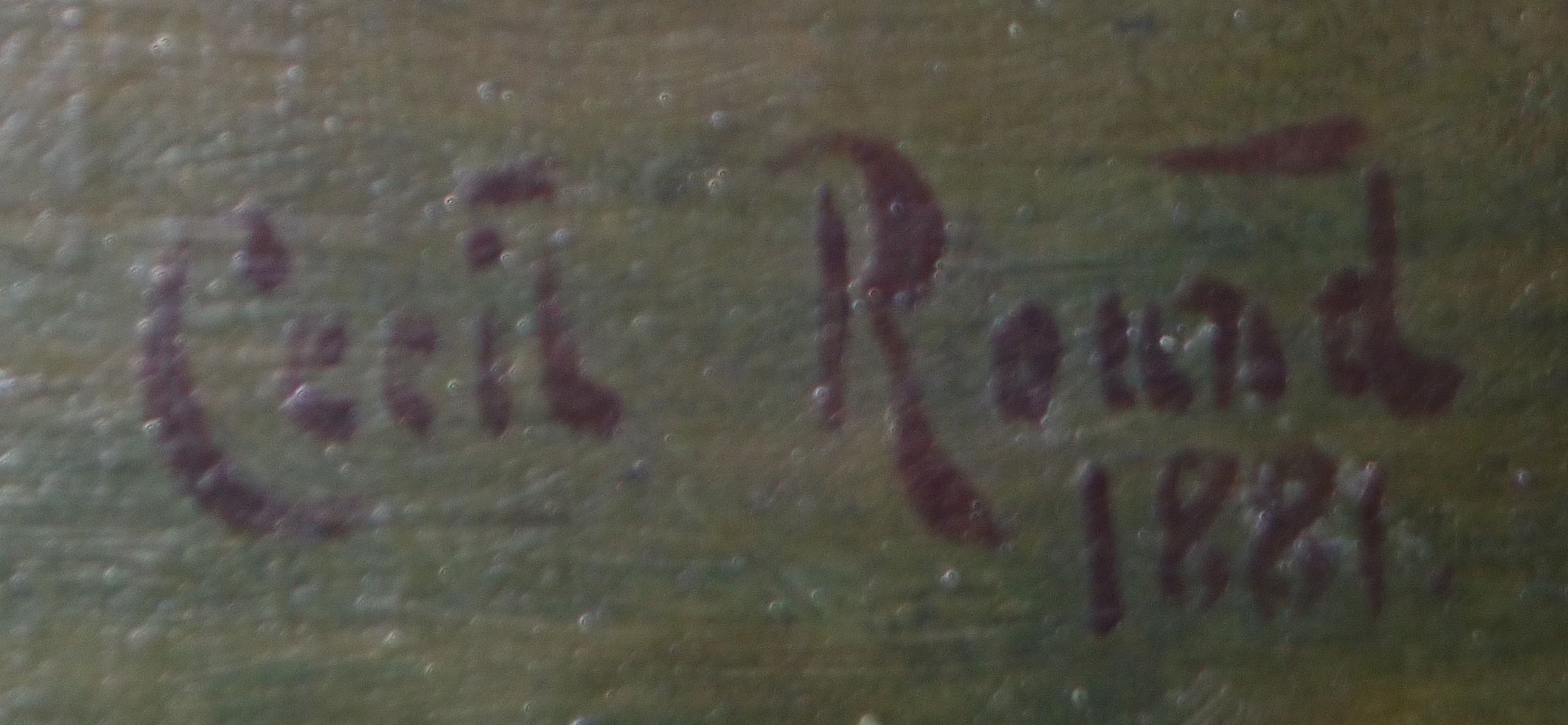 Chris kindly conducted some research into how the painting came to hang in the Lady Chapel – it was apparently donated to the church by the local Carter sisters in 1910; just three years after the church was built. Their father had come across Cecil Round’s work many years before and had admired the young artist’s work. For many years Ecce Homo hung on the pillar on the north side of the nave. Then it was removed to the middle of the south wall. At present it hangs on the south wall of the Lady Chapel. It was only in 2016 that Cecil Round’s signature was rediscovered on the painting, having previously been attributed to “an unknown artist”.
Chris kindly conducted some research into how the painting came to hang in the Lady Chapel – it was apparently donated to the church by the local Carter sisters in 1910; just three years after the church was built. Their father had come across Cecil Round’s work many years before and had admired the young artist’s work. For many years Ecce Homo hung on the pillar on the north side of the nave. Then it was removed to the middle of the south wall. At present it hangs on the south wall of the Lady Chapel. It was only in 2016 that Cecil Round’s signature was rediscovered on the painting, having previously been attributed to “an unknown artist”.
If you happen to be in London, why not visit St Luke’s for yourself, to view Cecil Round’s truly remarkable painting; perhaps en route to The National Gallery?
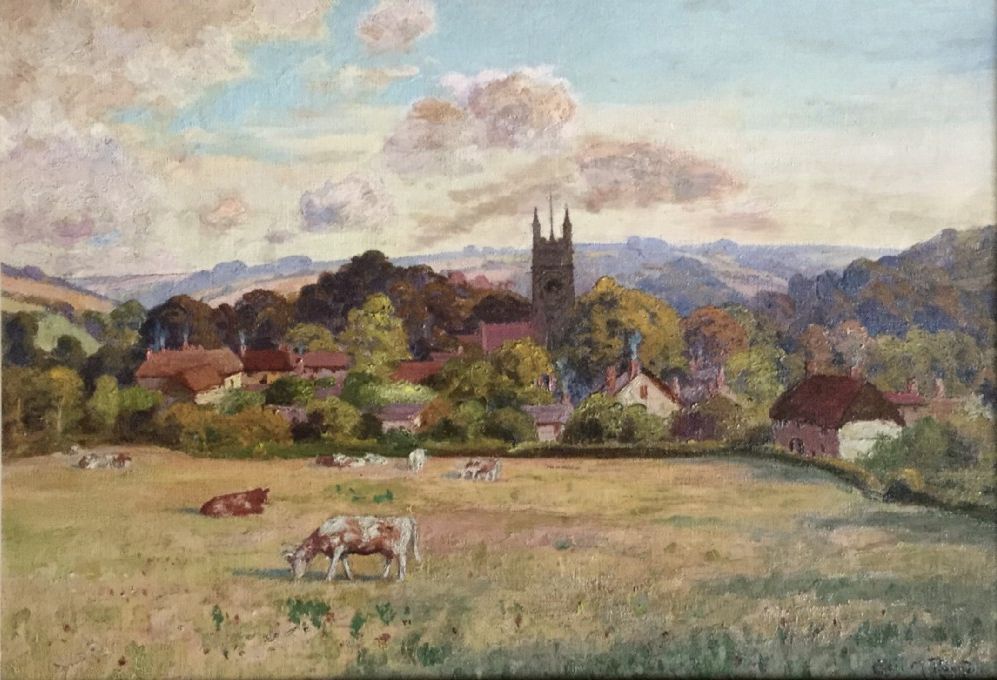


 Welcome to our twelfth ‘Spotlight Feature’. As a change to our normal review, rather than concentrate on a particular painting, this month we thought a more general appraisal of the changing face of Cecil Round’s signature, might add real value to the authentication of his work and to the general conversation about his painting.
Welcome to our twelfth ‘Spotlight Feature’. As a change to our normal review, rather than concentrate on a particular painting, this month we thought a more general appraisal of the changing face of Cecil Round’s signature, might add real value to the authentication of his work and to the general conversation about his painting. There appears to have been little consistency in terms of how Cecil Round signed his name – sometimes opting for ‘Cecil Round’, at other times, ‘Cecil M. Round’, sometimes ‘C. M. Round’ or even just ‘C. M. R.’. As such, rather than concentrate on the differences, let us instead focus on the similarities between all of the various incarnations:
There appears to have been little consistency in terms of how Cecil Round signed his name – sometimes opting for ‘Cecil Round’, at other times, ‘Cecil M. Round’, sometimes ‘C. M. Round’ or even just ‘C. M. R.’. As such, rather than concentrate on the differences, let us instead focus on the similarities between all of the various incarnations:
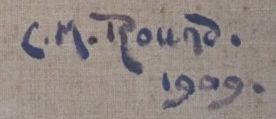
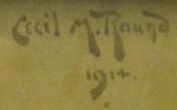 [Here is a sample selection of Cecil Round’s signature, highlighting the common features.]
[Here is a sample selection of Cecil Round’s signature, highlighting the common features.] The other area of commonality found with many artist’s signatures, is the location of its placement upon the board or canvas. However, it is fair to say that we have found no consistency in terms of where Cecil Round signed his paintings – front, rear or both; top or bottom, left or right corner or centre-rear. We’ve seen evidence of all of these locations or combinations thereof. As such, we conclude that it is the five distinguishing factors we have highlighted above, in terms of the style (rather than the position) of Cecil Round’s signature, that are the best pointers to authenticity.
The other area of commonality found with many artist’s signatures, is the location of its placement upon the board or canvas. However, it is fair to say that we have found no consistency in terms of where Cecil Round signed his paintings – front, rear or both; top or bottom, left or right corner or centre-rear. We’ve seen evidence of all of these locations or combinations thereof. As such, we conclude that it is the five distinguishing factors we have highlighted above, in terms of the style (rather than the position) of Cecil Round’s signature, that are the best pointers to authenticity.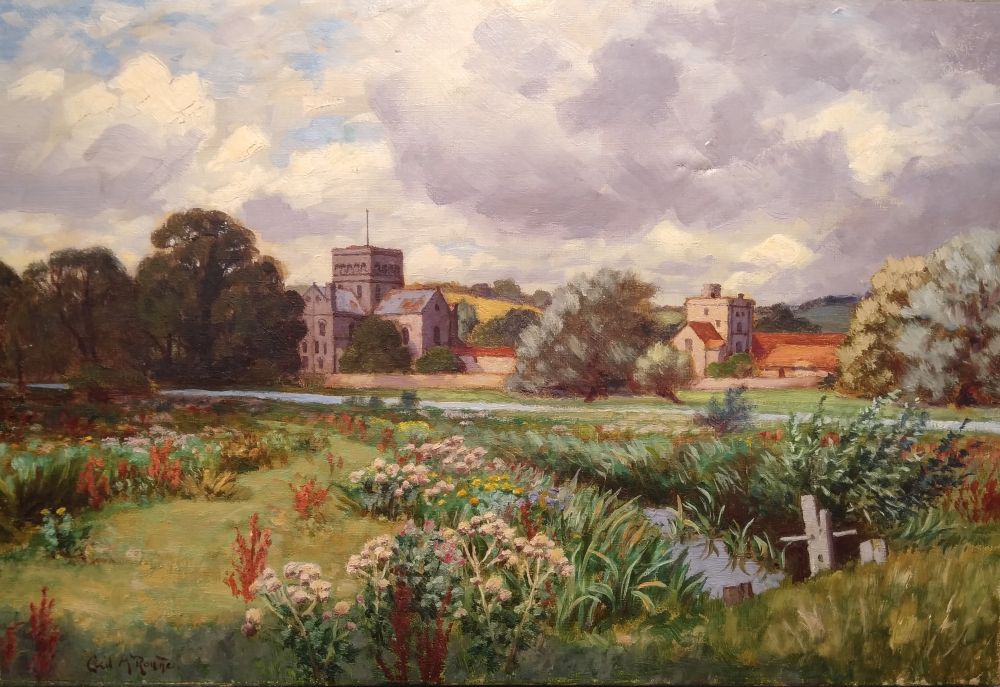 The
The 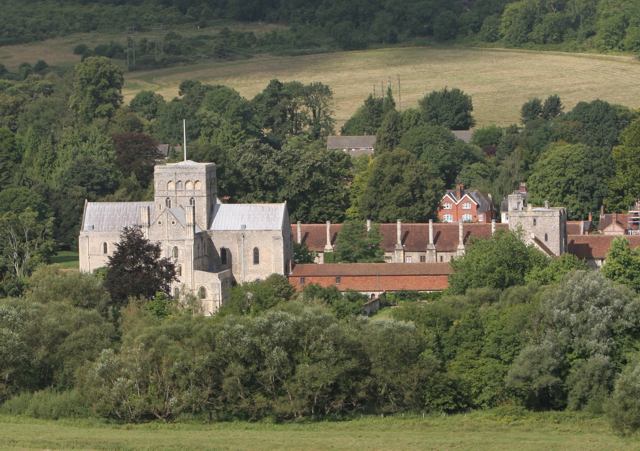
 Celia Halsey kindly contacted us last year with news about two paintings that have been in her family since they were commissioned in 1920. The subject of the paintings – her maternal grandfather, Charles George Harrison (aged 11 in 1920), and his younger brother, Stanley Ridd Harrison (aged 9). Both boys are wearing their school uniform, with Charles brandishing a cricket bat and George, the corresponding cricket ball.
Celia Halsey kindly contacted us last year with news about two paintings that have been in her family since they were commissioned in 1920. The subject of the paintings – her maternal grandfather, Charles George Harrison (aged 11 in 1920), and his younger brother, Stanley Ridd Harrison (aged 9). Both boys are wearing their school uniform, with Charles brandishing a cricket bat and George, the corresponding cricket ball.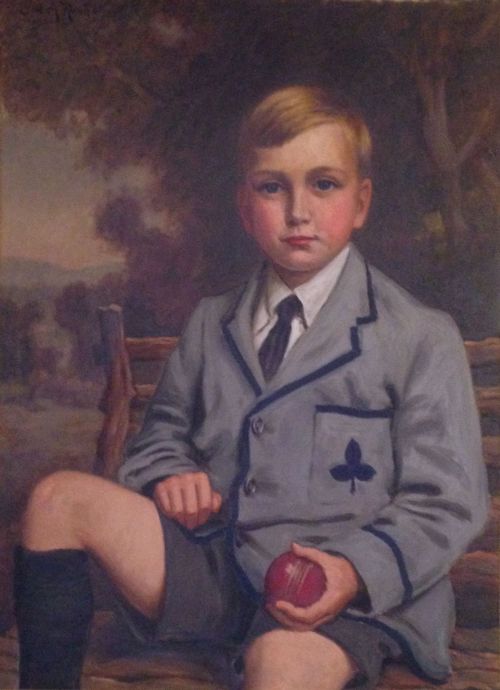 Celia takes up the story: “I have previously understood from my grandfather, that his parents commissioned these paintings from an artist friend and that there was some element of ‘helping him out after the war’ – either by the commissions themselves or the paintings being in lieu of owed money. However, no-one had been able to remember who the artist was. Now that I have inherited the second portrait from a great aunt, (reuniting them for the first time in 50 years) I was very pleased to find the signature in the top left-hand corner of ‘Stanley’.”
Celia takes up the story: “I have previously understood from my grandfather, that his parents commissioned these paintings from an artist friend and that there was some element of ‘helping him out after the war’ – either by the commissions themselves or the paintings being in lieu of owed money. However, no-one had been able to remember who the artist was. Now that I have inherited the second portrait from a great aunt, (reuniting them for the first time in 50 years) I was very pleased to find the signature in the top left-hand corner of ‘Stanley’.”
 Initially failing to sell, it was then offered for sale through an alternative auction house, where it sold as a real bargain! In fairness though, the low price may in part have been due to the auctioneer’s attribution of the painting to ‘a follower of Cecil Round’, rather than to Cecil Round himself, despite a clear signature in the bottom corner, appearing to be unquestionably that of the artist.
Initially failing to sell, it was then offered for sale through an alternative auction house, where it sold as a real bargain! In fairness though, the low price may in part have been due to the auctioneer’s attribution of the painting to ‘a follower of Cecil Round’, rather than to Cecil Round himself, despite a clear signature in the bottom corner, appearing to be unquestionably that of the artist.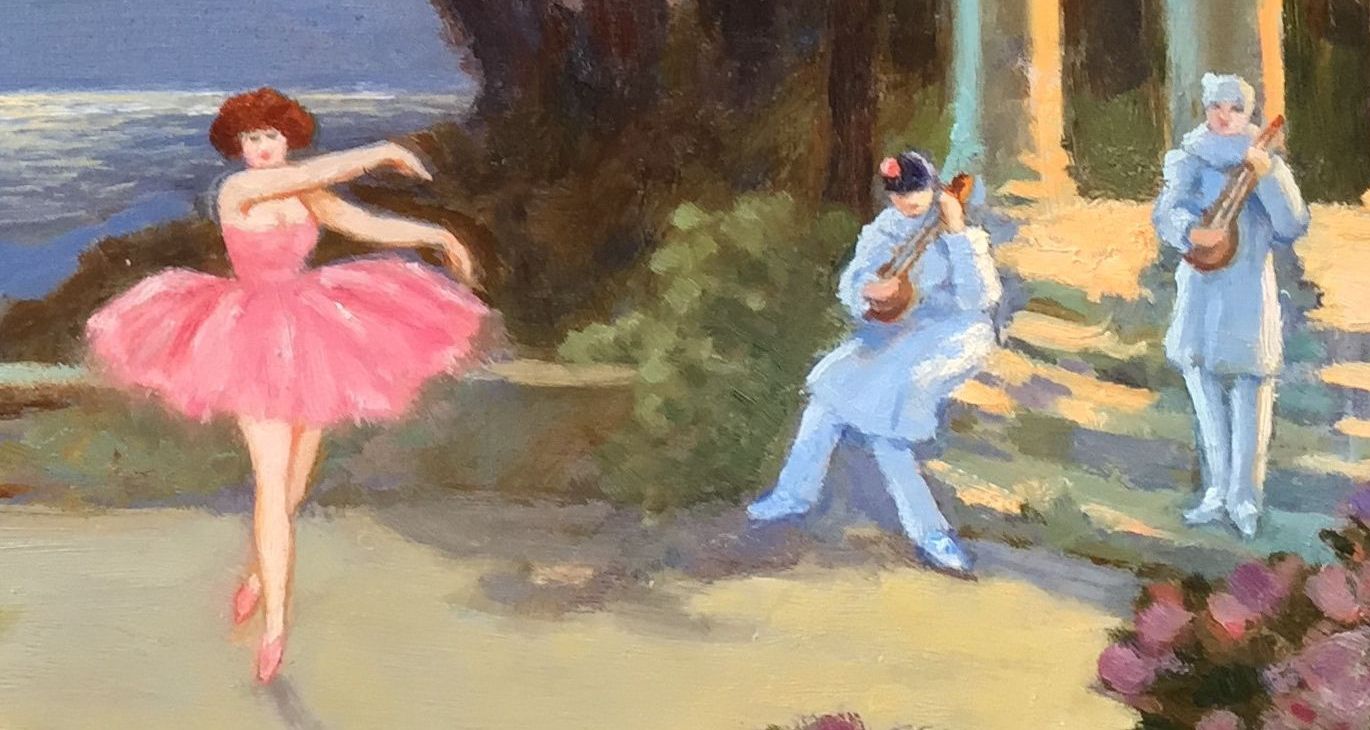 Examining the picture in more detail we find that Cecil Round appears to have captured an evening performance – a ballet dancer performing to the accompaniment of two musicians, playing their instruments (possibly banjos?) whilst dressed in costume. The scene is lit by make-shift lanterns with a full moon also shining brightly in the background beyond, over the sea. The garden back-drop is clearly rather grand – steps rise to a terrace where Corinthian columns rise majestically, like an impressive souvenir from a nineteenth century grand tour! Meanwhile, a low stone wall forms a parapet topped with stone vases and urns; a stone balustrade descends, presumably where steps (or a more gentle slope) lead down toward the sea; perhaps even to a private beach.
Examining the picture in more detail we find that Cecil Round appears to have captured an evening performance – a ballet dancer performing to the accompaniment of two musicians, playing their instruments (possibly banjos?) whilst dressed in costume. The scene is lit by make-shift lanterns with a full moon also shining brightly in the background beyond, over the sea. The garden back-drop is clearly rather grand – steps rise to a terrace where Corinthian columns rise majestically, like an impressive souvenir from a nineteenth century grand tour! Meanwhile, a low stone wall forms a parapet topped with stone vases and urns; a stone balustrade descends, presumably where steps (or a more gentle slope) lead down toward the sea; perhaps even to a private beach. The main dancer is resplendent in her pink tutu which compliments her auburn hair; styled in the period of the day. The second, seated dancer, wears an outfit suggesting the picture dates perhaps from the early 1920s. Whatever the occasion, the colours are bright and joyful – the lavish decorations suggest a celebration of some sort and the setting implies the event has a wealthy host.
The main dancer is resplendent in her pink tutu which compliments her auburn hair; styled in the period of the day. The second, seated dancer, wears an outfit suggesting the picture dates perhaps from the early 1920s. Whatever the occasion, the colours are bright and joyful – the lavish decorations suggest a celebration of some sort and the setting implies the event has a wealthy host.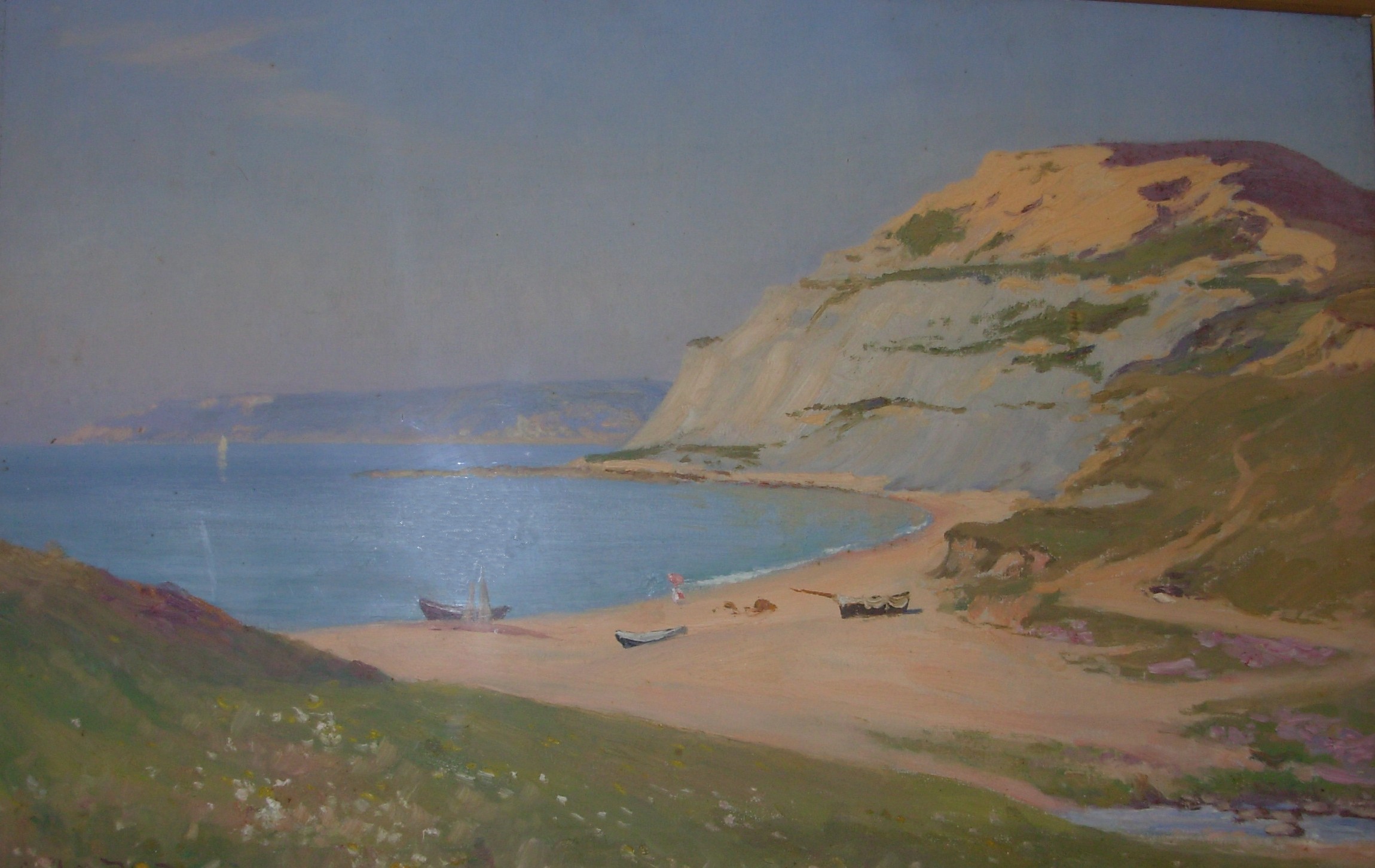 The Golden Cap, which derives its name from the distinctive outcropping of golden greensand rock near its summit, is a hill which is located on the coast of the English Channel, between Bridport and Charmouth, in Dorset. At 191m above sea level, it is actually the highest point on the South Coast of Great Britain and is visible for miles along the coastline. Today, the hill is owned by the National Trust and, forms part of the Jurassic Coast; a World Heritage Site. It is accessible via a coastal footpath from Seatown, and takes around 40 minutes to reach the summit.
The Golden Cap, which derives its name from the distinctive outcropping of golden greensand rock near its summit, is a hill which is located on the coast of the English Channel, between Bridport and Charmouth, in Dorset. At 191m above sea level, it is actually the highest point on the South Coast of Great Britain and is visible for miles along the coastline. Today, the hill is owned by the National Trust and, forms part of the Jurassic Coast; a World Heritage Site. It is accessible via a coastal footpath from Seatown, and takes around 40 minutes to reach the summit.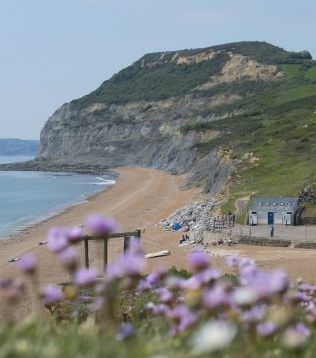 Shortly after creating the Cecil Round website, we were pleased to hear from Gabrielle Mellor who had inherited the painting from her father. Having been brought up in the area, she had particularly fond memories of the Golden Cap and observed how, unlike many artists, Cecil Round had correctly captured the light, within his painting.
Shortly after creating the Cecil Round website, we were pleased to hear from Gabrielle Mellor who had inherited the painting from her father. Having been brought up in the area, she had particularly fond memories of the Golden Cap and observed how, unlike many artists, Cecil Round had correctly captured the light, within his painting.
 [Correggio’s Ecce Homo reproduced here with kind permission from The National Gallery, under their Creative Commons agreement.]
[Correggio’s Ecce Homo reproduced here with kind permission from The National Gallery, under their Creative Commons agreement.] Chris kindly conducted some research into how the painting came to hang in the Lady Chapel – it was apparently donated to the church by the local Carter sisters in 1910; just three years after the church was built. Their father had come across Cecil Round’s work many years before and had admired the young artist’s work. For many years Ecce Homo hung on the pillar on the north side of the nave. Then it was removed to the middle of the south wall. At present it hangs on the south wall of the Lady Chapel. It was only in 2016 that Cecil Round’s signature was rediscovered on the painting, having previously been attributed to “an unknown artist”.
Chris kindly conducted some research into how the painting came to hang in the Lady Chapel – it was apparently donated to the church by the local Carter sisters in 1910; just three years after the church was built. Their father had come across Cecil Round’s work many years before and had admired the young artist’s work. For many years Ecce Homo hung on the pillar on the north side of the nave. Then it was removed to the middle of the south wall. At present it hangs on the south wall of the Lady Chapel. It was only in 2016 that Cecil Round’s signature was rediscovered on the painting, having previously been attributed to “an unknown artist”.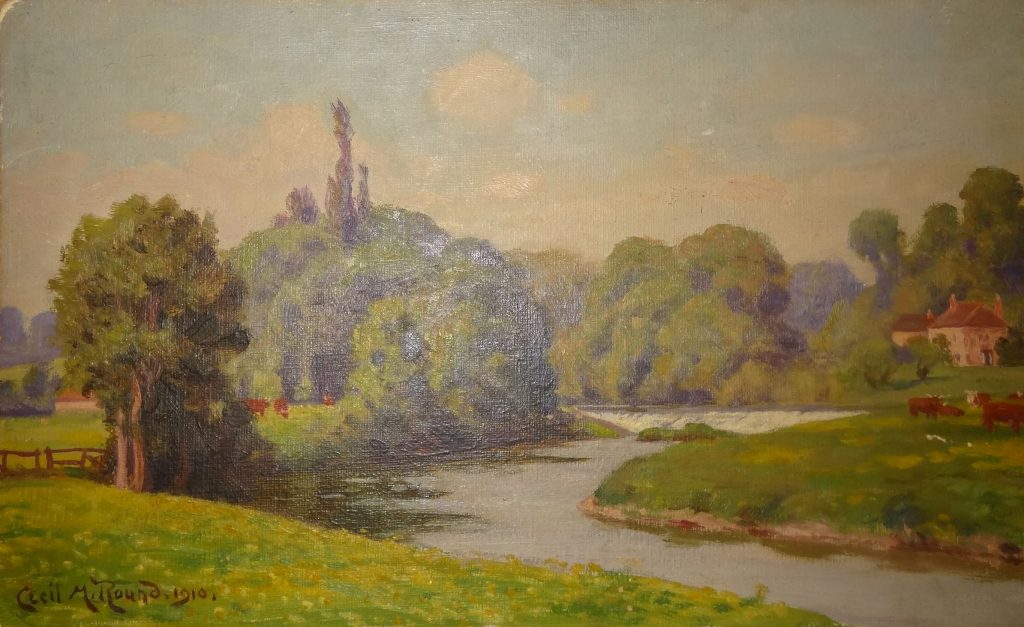
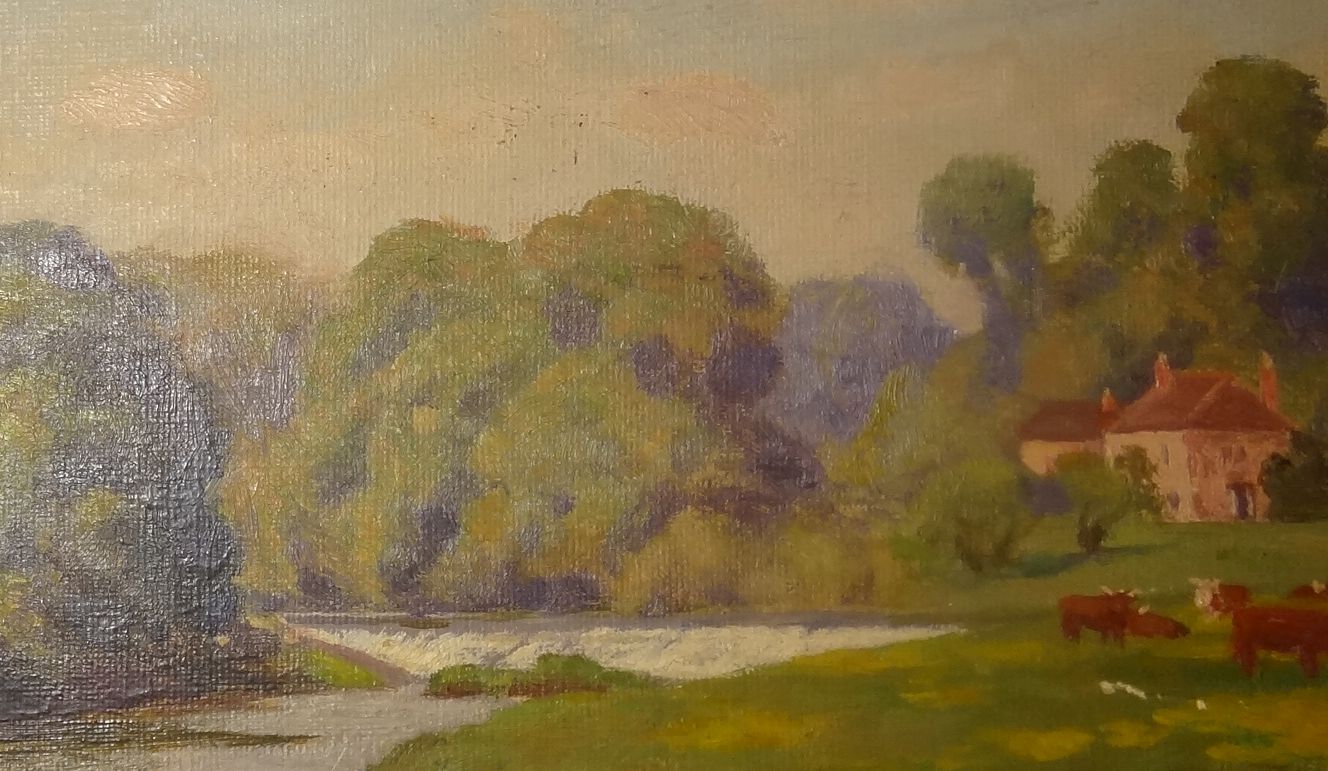 Looking through our online gallery, you will see that the majority of paintings that have dates attributed to the period around 1910, are of subjects within the county of Devon. As such, although we can’t say for certain, we can assume the mystery painting is also of a Devon scene – certainly the meandering river, grazing cattle, distant farm house and what is fundamentally a pastural scene, is not out of keeping with this county.
Looking through our online gallery, you will see that the majority of paintings that have dates attributed to the period around 1910, are of subjects within the county of Devon. As such, although we can’t say for certain, we can assume the mystery painting is also of a Devon scene – certainly the meandering river, grazing cattle, distant farm house and what is fundamentally a pastural scene, is not out of keeping with this county.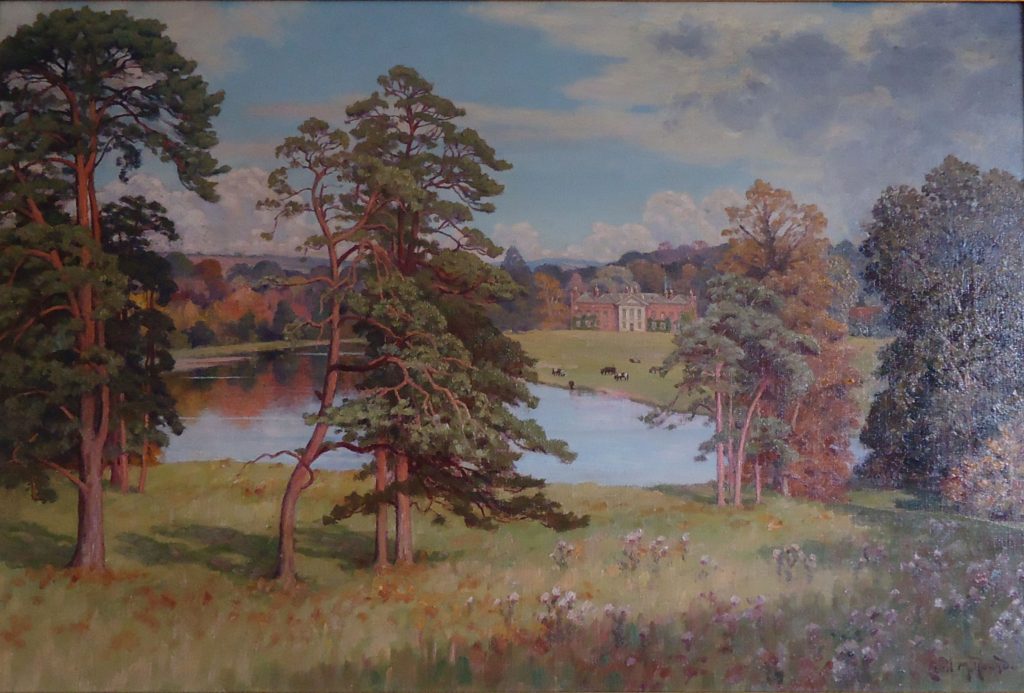
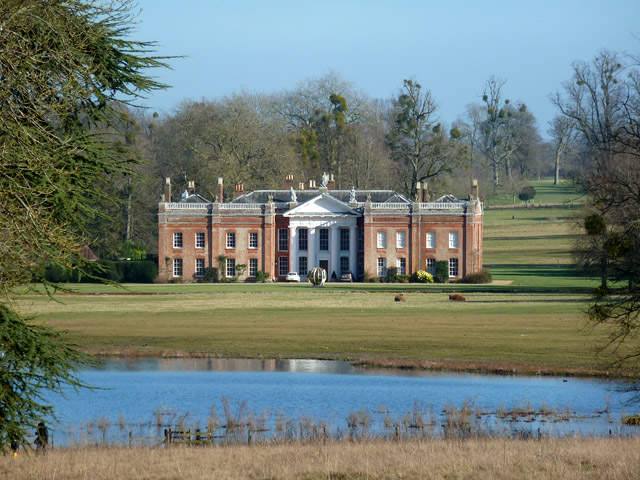 Avington Park is a privately owned stately home. It is located east of Winchester, in the beautiful Itchen Valley, set in its own parkland bordering the River Itchen. Once described by William Cobbett as “one of the prettiest places in the County”, the house and grounds (including tea room), are open to the public every Sunday and bank holiday Monday, from 5th May to 29th September, 2019 (inclusive). Groups are welcome at other times by appointment throughout the year. In addition to this, the property also serves as a wedding and events venue.
Avington Park is a privately owned stately home. It is located east of Winchester, in the beautiful Itchen Valley, set in its own parkland bordering the River Itchen. Once described by William Cobbett as “one of the prettiest places in the County”, the house and grounds (including tea room), are open to the public every Sunday and bank holiday Monday, from 5th May to 29th September, 2019 (inclusive). Groups are welcome at other times by appointment throughout the year. In addition to this, the property also serves as a wedding and events venue.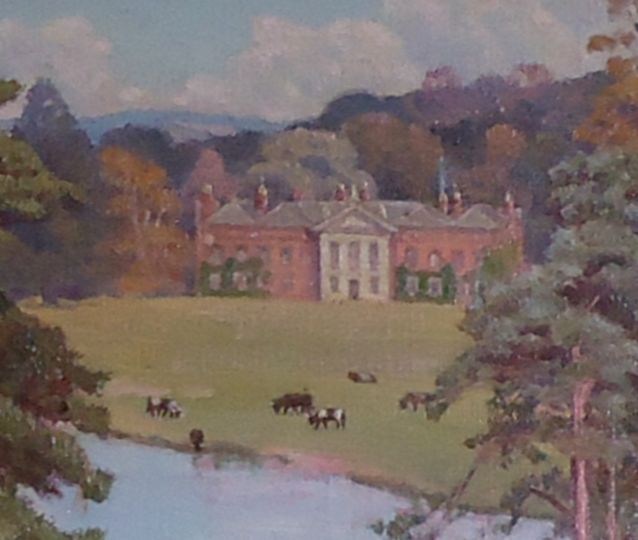 Returning to the painting, we contacted the auction house who kindly collaborated in putting us in touch with the person who had purchased the art work. It transpired that he was in the trade and, although we weren’t initially able to do business, we shared news of the subject matter being Avington Park; hoping that whoever went on to purchase the painting from him, would be all the more appreciative of Cecil Round’s work.
Returning to the painting, we contacted the auction house who kindly collaborated in putting us in touch with the person who had purchased the art work. It transpired that he was in the trade and, although we weren’t initially able to do business, we shared news of the subject matter being Avington Park; hoping that whoever went on to purchase the painting from him, would be all the more appreciative of Cecil Round’s work.